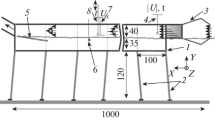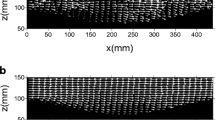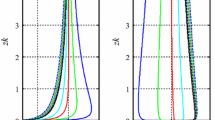Abstract—Formulas for the vertical wind-wave-induced mixing coefficient are obtained. For this purpose, in the Navier–Stokes equations the flow velocity is decomposed into four components, namely, mean flow, wave orbital motion, wave-induced turbulent flow fluctuations, and background turbulent fluctuations. Such a decomposition makes it possible to distinguish the wave stress Rew in the Reynolds equations as an addition to the background stress Reb. For the background turbulent fluctuations the Prandtl approximation is used for closure of Rew. This leads to an implicit expression for the wave-induced vertical mixing function \({{B}_{v}}\). The finite expression for \({{B}_{v}}\) is determined using author’s results for the turbulent viscosity in the wave zone found earlier within the framework of the three-layer conception for the air-water interface. The explicit expression for the function \({{B}_{v}}(a,{{u}_{*}},z)\) is linear with respect to the wave amplitude a(z) at the depth z and the friction velocity u* in air. Since the wave amplitude decreases exponentially as a function of the depth, this result for \({{B}_{v}}(a)\) means the possibility of strengthening the wave impact on vertical mixing as compared with the well-known cubic dependence of \({{B}_{v}}(a)\).

Similar content being viewed by others
REFERENCES
Kitaigorodskii, S.A. and Lumley, J.L., Wave-turbulence interaction in the upper ocean. Pt. I. The energy balance in the interacting fields of surface waves and wind-induced three-dimensional turbulence, J. Phys. Oceanogr., 1983, vol. 13, pp. 1977–1987.
Kantha, L.H. and Clayson, C.A., An improved mixed layer model for geophysical applications, J. Geophys. Res., 1994, vol. 99, pp. 25 235–25 266.
Ezer, T., On the seasonal mixed layer simulated by a basin-scale ocean model and the Mellor–Yamada turbulence scheme, J. Geophys. Res., 2000, vol. 105, pp. 16843–16855.
Mellor, G.L. and Yamada, T., Development of a turbulence closure model for geophysical fluid problems, Rev. Geophys. Space Phys., 1982, vol. 20, pp. 851–875.
Qiao, F., Yuan, Y., Yang, Y., Zheng, Q., Xia, C., and Ma, J., Wave-induced mixing in the upper ocean: Distribution and application to a global ocean circulation model, Geophys. Res. Lett., 2004, vol. 31, p. L11303. https://doi.org/10.1029/2004GL019824
Babanin, A.V. and Chalikov, D., Numerical investigation of turbulence generation in non-breaking potential waves, J. Geophys. Res., 2012, vol. 117, p. C00J17. https://doi.org/10.1029/2012JC007929
Qiao, F., Yuan, Y., Deng, J., Dai, D., and Song, Z., Wave–turbulence interaction-induced vertical mixing and its effects in ocean and climate models, Phil. Trans. R. Soc., 2016, vol. A374, p. 20150201. https://doi.org/10.1098/rsta.2015.0201
Aijaz, S., Ghantous, M., Babanin, A.V., Ginis, L., Thomas, B., and Wake, G., Nonbreaking wave-induced mixing in upper ocean during tropical cyclones using coupled hurricane-ocean-wave modeling, J. Geophys. Res. Oceans, 2017, vol. 122, pp. 3939–3963. https://doi.org/10.1002/2016JC012219
Wals, K., Govekar, P., Babanin, A.V., Ghantous, M., Spence, P., and Scoccimarro, F., The effect on simulated ocean climate of a parameterization of unbroken wave-induced mixing incorporated into the k-epsilon mixing scheme, J. Adv. Model. Earth Syst., 2017, vol. 9, pp. 735–758. https://doi.org/10.1002/2016MS000707
Monin, A.C. and Yaglom, A.Ya., Statisticheskaya gidromekhanika (Statistical Hydrodynamics), Vol. 2, Moscow: Nauka, 1967.
Anis, A. and Moum, J.N., Surface wave–turbulence interactions: Scaling ε(z) near the sea surface, J. Phys. Oceanogr., 1995, vol. 25, pp. 2025–2045.
Ardhuin, F. and Jenkins, A.D., On the interaction of surface waves and upper ocean turbulence, J. Phys. Oceanogr., 2006, vol. 36, pp. 551–557. https://doi.org/10.1175/JPO2862.1
Janssen, P.E.A.M., Ocean wave effects on the daily cycle in SST, J. Geophys. Res. 2012, vol. 117, p. C00J32. https://doi.org/10.1029/2012JC007943
Craig, P.D. and Banner, M.L., Modelling wave enhanced turbulence in the ocean surface layer, J. Phys. Oceanogr., 1994, vol. 24, pp. 2547–2559.
Babanin, A.V., On a wave-induced turbulence and a wave-mixed upper ocean layer, Geophys. Res. Lett. 2006, vol. 33, p. L20605. https://doi.org/10.1029/2006GL027308
Babanin, A.V. and Haus, B.K., On the existence of water turbulence induced by non-breaking surface waves, J. Phys. Oceanogr., 2009, vol. 39, pp. 2675–2679. https://doi.org/10.1175/2009JPO4202.1
Gemmrich, J.R. and Farmer, D.M., Near-surface turbulence in the presence of breaking waves, J. Phys. Oceanogr., 2004, vol. 34, pp. 1067–1086.
Gemmrich, J.R., Strong turbulence in the wave crest region, J. Phys. Oceanogr., 2010, vol. 40, pp. 583–595. https://doi.org/10.1175/2009JPO4179.1
Dai, D., Qiao, F., Sulisz, W., Han, L., and Babanin, A., An experiment on the nonbreaking surface-wave-induced vertical mixing, J. Phys. Oceanogr., 2010, vol. 40, pp. 2180–2188.
Pleskachevsky, A., Dobrynin, M., Babanin, A.V., Günther, H., and Stanev, E., Turbulent mixing due to surface waves indicated by remote sensing of suspended particulate matter and its implementation into coupled modeling of waves, turbulence and circulation, J. Phys. Oceanogr., 2011, vol. 41, pp. 708–724.
Sutherland, P. and Melville, W.K., Field measurements of surface and near-surface turbulence in the presence of breaking waves, J. Phys. Oceanogr., 2015, vol. 45, pp. 943–965. https://doi.org/10.1175/JPO-D-14-0133.1
Benilov, A.Y., On the turbulence generated by the potential surface waves, J. Geophys. Res., 2012, vol. 117, p. C00J30. https://doi.org/10.1029/2012JC007948
Qiao, F., Yuan, Y., Ezer, T., Xia, C., Yang, Y., Lü, X., and Song, Z., A three-dimensional surface wave-ocean circulation coupled model and its initial testing, Ocean Dynamics, 2010, vol. 60, pp. 1339–1355.
Huang, C.J., Qiao, F., Dai, D., Ma, H., and Guo, J., Field measurement of upper ocean turbulence dissipation associated with wave-turbulence interaction in the South China Sea, J. Geophys. Res., 2012, vol. 17, p. C00J09. https://doi.org/10.1029/2011JC00780
Yuan, Y., Qiao, F., Yin, X., and Han, L., Analytical estimation of mixing coefficient induced by surface wave-generated turbulence based on the equilibrium solution of the second-order turbulence closure model, Science China: Earth Sciences, 2013, vol. 56. pp. 71–80. https://doi.org/10.1007/s11430-012-4517-x
Polnikov, V.G., A semi-phenomenological model for wind-induced drift currents, Boundary-Layer Meteorol., 2019, vol. 172(3), pp. 417–433. https://doi.org/10.1007/s10546-019-00456-1
Polnikov, V.G., Features of air flow in the trough-crest zone of wind waves (2010). https://arxiv.org/abs/1006.3621.
Longo, S., Chiapponi, L., Clavero, M., Mäkel, T., and Liang, D., The study of the turbulence over the air-side and the water-induced boundary waves, Coastal Engineering, 2012, vol. 69, pp. 67–81.
Chalikov, D. and Rainchik, S., Coupled numerical modelling of wind and waves and theory of the wave boundary layer, Boundary-Layer Meteorol., 2011, vol. 138, pp. 1–41. https://doi.org/10.1007/s10546-010-9543-7
Skote, M. and Henningson, D.S., Direct numerical simulation of a separated turbulent boundary layer, J. Fluid Mech., 2002, vol. 471, no. 1, pp. 107–136.
Jones, N.L. and Monismith, S.G., The influence of whitecapping waves on the vertical structure of turbulence in a shallow estuarine embayment, J. Phys. Oceanogr., 2008, vol. 38, pp. 1563–1580. https://doi.org/10.1175/2007JPO3766.1
Komen, G.I., Cavaleri, L., Donelan, M., Hasselmann, K., Hasselmann, S., and Janssen P.A.E.M., Dynamics and Modelling of Ocean Waves, Cambridge: Cambridge University Press, 1994.
ACKNOWLEDGMENTS
The author wishes to thank China scientists, Profs. N. Huang and D. Dai, for their useful comments and advices during preliminary discussion of the problem considered.
Funding
The work was supported by the Russian Foundation for Basic Research, project no. 18-05-00161.
Author information
Authors and Affiliations
Corresponding author
Additional information
Translated by E. A. Pushkar
EXPLANATION OF FORMULA (1.18)
EXPLANATION OF FORMULA (1.18)
Formula (1.18) is constructed on the basis of three theoretical and experimental facts [26, 28]:
1) on the water surface the wind drift velocity is of the order of \(0.5{{u}_{*}}\);
2) in the wave zone the drift velocity profile is linear with respect to z;
3) the thickness of the wave zone is of the order of 3а0, where а0 is the mean wave height [27, 28] (see explanation to Fig. 1).
Under the assumption that in the wave zone the flow velocity varies from Ud0 (on the boundary with the driving atmosphere layer) to the friction velocity in water \({{u}_{{*w}}} \approx {{(ro)}^{{1/2}}}{{u}_{*}} \approx 0.03{{u}_{*}} \ll {{U}_{{d0}}}\) (on the boundary with the upper water layer), in the wave zone we can write the balance equation for the flux of momentum of the form:
Here,
is the vertical flux of momentum in water divided by the water density; \(ro = ({{\rho }_{a}}{\text{/}}{{\rho }_{w}}) \approx {{10}^{{ - 3}}}\) is the ratio of the air and water densities; \({{u}_{{*w}}}\) is the friction velocity in water; and \({{K}_{{\text{t}}}}_{{\text{w}}}\) is the unknown turbulent mixing (or viscosity) coefficient in the wave zone. On the right-hand side of (A1) the flow velocity gradient is determined by the drift velocity gradient in the wave zone. In accordance with the above, the latter is of the order \(\partial {{U}_{d}}{\text{/}}\partial z \approx {{U}_{{d0}}}{\text{/}}3a\) since on the lower boundary of the wave zone the drift velocity is of the order of the friction velocity in water \({{u}_{{*w}}}\), i.e., much less than Ud0 ≈ 0.5\({{u}_{*}}\).
Substituting expression (A2) and Ud0 in Eq. (A1), we obtain the expression for the turbulent viscosity coefficient \({{K}_{{\text{t}}}}_{{\text{w}}}\) of the form (1.18).
Rights and permissions
About this article
Cite this article
Polnikov, V.G. Model of Vertical Mixing Induced by Wind Waves. Fluid Dyn 55, 20–30 (2020). https://doi.org/10.1134/S0015462820010103
Received:
Revised:
Accepted:
Published:
Issue Date:
DOI: https://doi.org/10.1134/S0015462820010103




